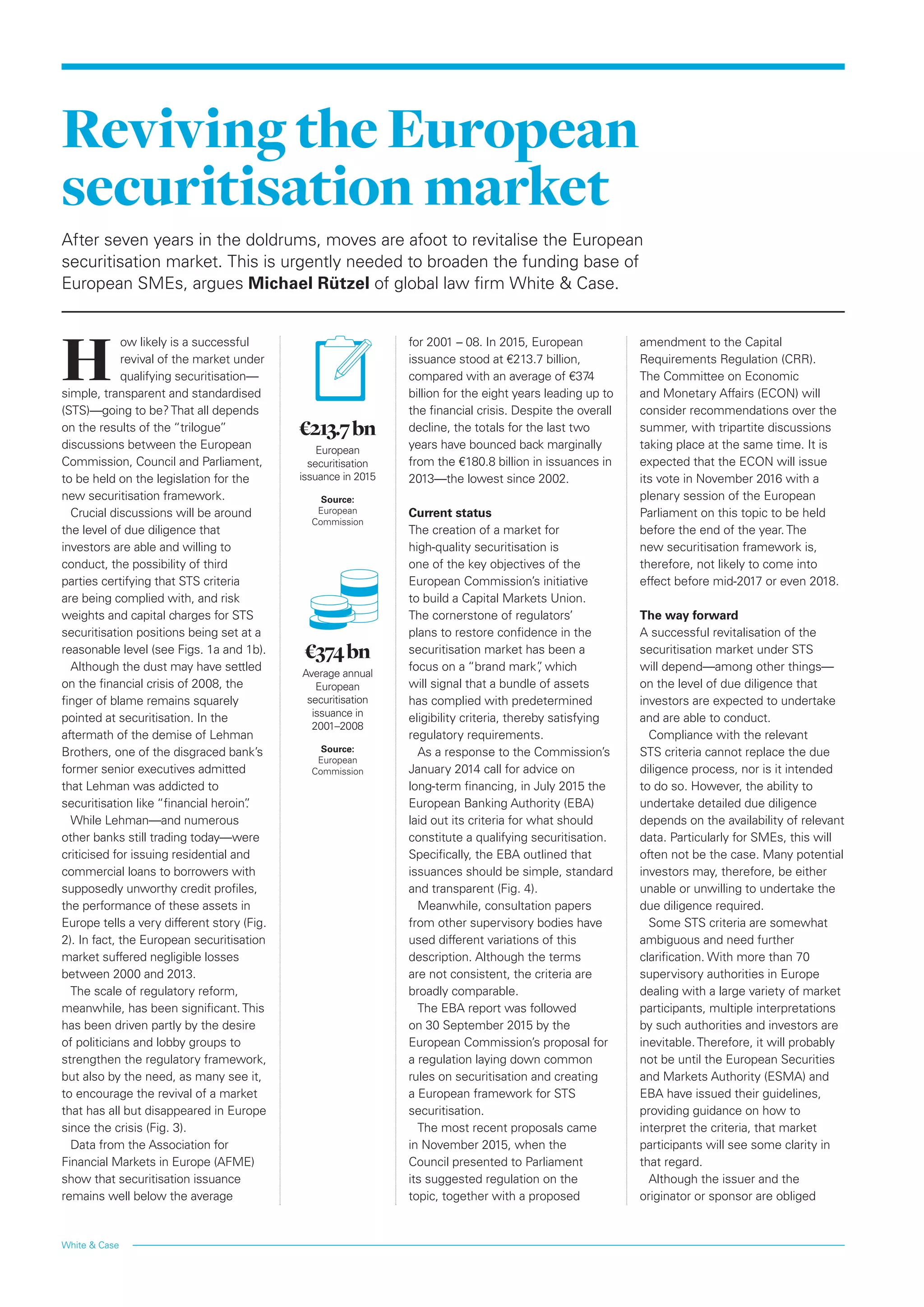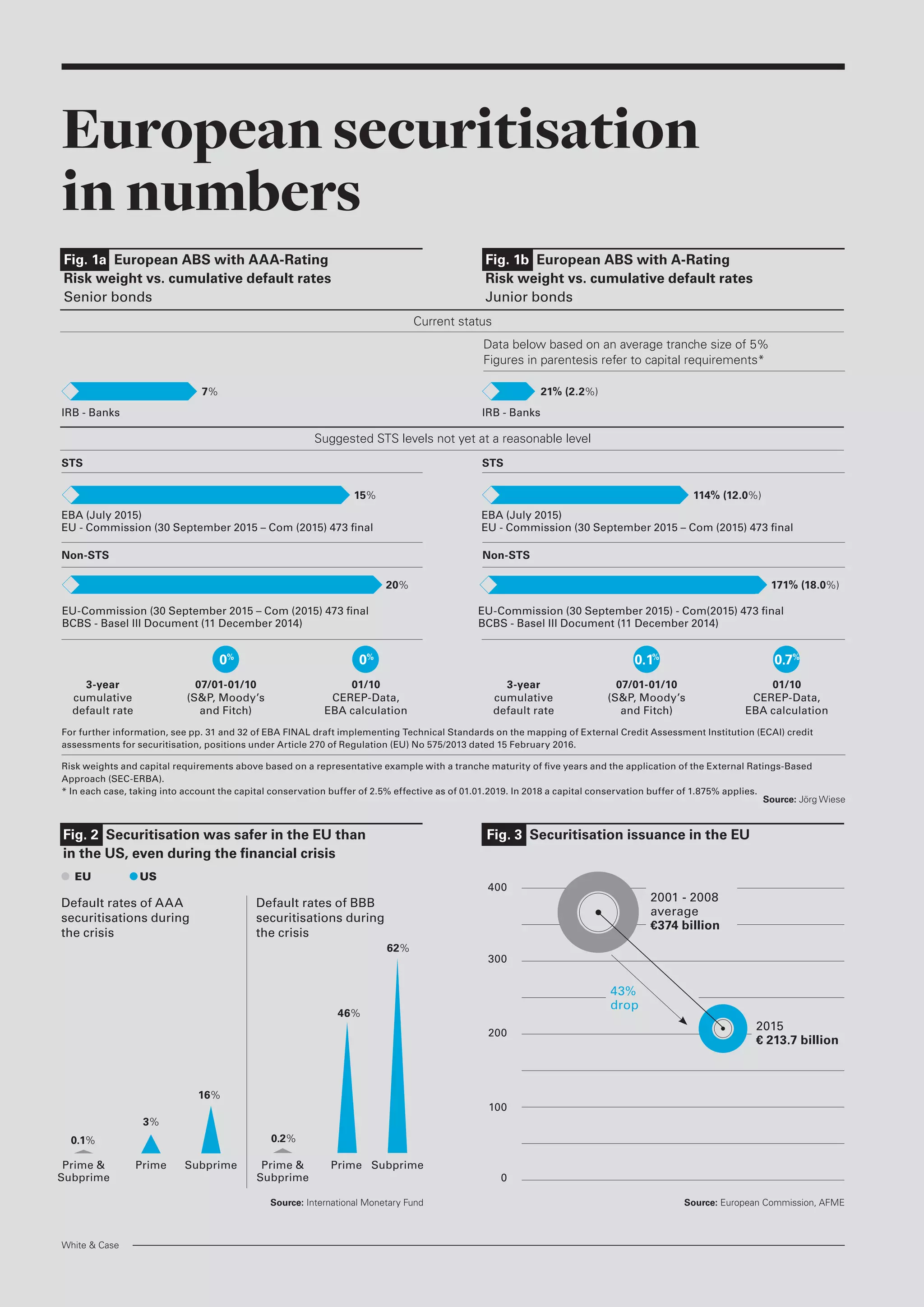1) The document discusses the potential for a revival of the European securitization market under new STS (simple, transparent, and standardized) criteria.
2) Key to a successful revival will be the results of discussions around appropriate due diligence requirements, third party certification, and reasonable capital charges and risk weights for STS securitizations.
3) Several challenges remain around clarifying ambiguous STS criteria, ensuring definitions are practical, and establishing consistent regulatory treatment for banks and insurance companies to incentivize investment.


![European securitisation: Making a comeback?
applicable to insurance companies,
even with an STS label, are simply
prohibitive and discriminating (Fig. 6).
The Solvency II Directive requires
insurance companies to reflect
the spread risk, which implies
that price losses in situations of
extreme market stress would need
to be realised. However, due to their
amortisation profile, such positions
are normally held until maturity
based on a buy-and-hold approach.
A viable way forward could be to
grant insurance companies the same
option afforded to banks, in which
only the default risk is assigned a
certain capital charge.
To achieve a revitalisation of the
market, it is essential to incentivise
insurance companies to invest in
securitisation positions again. With
European insurance companies
boasting investment capital of
almost €10 trillion at the end of 2014
according to Investment Europe,
investing just 5 per cent of this in
securitisation positions would provide
a €500 billion boost to the sector.
Finally, without reviving the ABCP
market—the volume of which in
Germany alone is about €12 billion—
any attempt to support SME financing
in Europe is surely doomed to fail.
Overcoming challenges
Experts argue that there is still much
work to be done if a revitalisation of
the market is to be achieved.
Lynn Maxwell, global head of
securitisation and managing director
of structured capital markets at
HSBC, says that while regulatory
work has focussed on differentiating
between poorly and strongly
performing assets, there are several
obstacles still to overcome.
“Challenges remain to ensure that
the STS/STC [simple, transparent
and comparable] definitions are not
too narrow for practical application
and to recognise the value of the
STS/STC criteria in the bank and
insurance prudential and liquidity
regimes,” she explains.
Maxwell’s views are shared by
many in the market, with industry
practitioners calling for any new
to notify ESMA about the criteria
being satisfied, ESMA will not be
required to check the accuracy of
this information. For investors to
be confident that STS criteria are
being complied with, therefore,
the importance of certification by
an independent third party—as
proposed by the European Council—
should not be underestimated.
Despite zero per cent default rates
for AAA and AA-rated European
asset-backed securities, the risk
weights—and, therefore, capital
requirements—are intended to be
increased significantly. A minimum
risk weight of 15 (or, in exceptional
cases, 10) per cent for senior STS
securitisation positions are also
being suggested, along with a new
method for determining capital
charges in the proposed amendment
to the CRR. Although this is a
much lower level than currently
proposed by the Basel Committee
for the securitisation framework to
come into effect in 2018, it is still
significantly higher than the currently
applicable minimum risk weight of
7 per cent for AAA-rated regular
securitisation positions held by IRB
institutions being the most significant
investors from the banking sector.
Therefore, today‘s minimum risk
weight should continue to be applied
to STS securitisations for banks
and that irrespective of the method
applied to calculate their regulatory
capital requirement. A similar picture
appears when looking at junior
bonds, where capital requirements
will increase dramatically (in the
example shown in Fig. 1b for
non- STS securitisation by a factor
of 8.2 and for STS securitisations
by a factor of 5.5). Hence, even
for STS securitisations, the capital
requirements significantly exceed the
actual default rates experienced in
the past (Fig. 1b).
If STS securitisations are intended
to be a cornerstone of the Capital
Markets Union project—and a means
of improving SMEs’ access to the
capital markets—a number of criteria
for asset-backed securities and asset-
backed commercial paper (ABCP)
transactions and programmes first
need to be revised and clarified.
Moreover, the market needs to
adopt a more consistent regulatory
treatment of banks and insurance
companies (Fig. 5). Capital charges
for securitisation positions currently
standard to adequately take into
account the specific financing needs
of the “real” global economy.
Dr Reinhard Kudiß, senior manager,
corporate finance, financial markets
research, economic and industrial
policy at BVI, explains: “Capital
requirements of STS securitisations
should properly reflect the high
quality of real sector-based
securitisations.
“We regard the risk-weight
calibration of STS securitisations
as clearly too high versus other
unsecured sources of funding.”
He says the capital adequacy
requirements for STS asset-backed
securities programmes differ from
the previous requirements for
securitisation positions and from the
capital requirements for covered and
corporate bonds.The absence of
a level playing field in these capital
requirements, meanwhile, not only
affects how these assets are legally
perceived but could also affect the
economy.
Kudiß adds: “The restrictive
eligibility criteria for STS
securitisations could deprive SMEs
of benefiting from ABS transactions.
“The process of regulatory
recognition of STS securitisation, the
ongoing supervision of compliance
with the criteria and the sanctioning
process in the case of infringement
provides incalculable uncertainties
and risks.”
HSBC’s Maxwell agrees, calling
for more to be done to ensure
that liquidity coverage ratio
requirements are aligned for
STS and covered bonds.
She adds: “I would also like to see
the STS recognise that the sovereign
cap in certain countries should not
bar high-quality securitisations from
those jurisdictions from eligibility.
“It is important to ward against
a too narrow definition of liquidity
coverage ratios, especially as the
performance of European asset-
backed securities through the crisis
does not justify a narrow approach.”
Further justification is needed from
regulators on the proposed capital
requirements for investments in
ABS and the outlined guidance on
liquidity ratios.
As ever, though, the devil will be in
the detail. And in the meantime, the
market is hoping for a wise decision
out of Brussels and Strasburg, and
sooner rather than later.
Removing the stigma of
securitisation is central to
the revival of the market
The author would
like to thank
Lynn Maxwell,
Dr Reinhard
Kudiß and Jörg
Wiese for their
contributions to
this article.](https://image.slidesharecdn.com/dae7660c-101c-4ddd-b849-a66a0b96f1b0-160602121342/75/European-securitisation-Making-a-comeback-May-2016-3-2048.jpg)

![European securitisation: Making a comeback?
Senior bonds (AAA-rated) Junior bonds (A-rated)
1.7%*
37.5%**
Type 2
49.8%**
Current status:
IRB-Bank
Solvency IISolvency II
Type 1
3-year cumulative default rate ***
(07/01-01/10)
0%for senior bonds
0.1% for junior bonds
0.6%
6.3%**
* Assuming the currently applicable capital requirement of 8%.
** Before risk mitigating effects (correlation <1; techn. reserves and lat. taxes)
*** S&P, Moody’s and Fitch. See pp. 31 and 32 of EBA FINAL draft implementing
Technical Standards on the mapping of External Credit Assessment Institution
(ECAI) credit assessments for securitisation positions under Article 270 of
Regulation (EU) No 575/2013 dated 15 February 2016. ****See minimum capital
requirements for market risk, BCBS 14.01.16
Source: Jörg Wiese
Underlying Credit Risk criteria
• Underwriting standards
• Granularity
• Maximum risk weights
Mitigates risks of the securitisations process
Mitigates underlying risk
Underlying risk
A
B
Pillar I:
Simple
• No leverage
• Legal true sale
• Homogeneous
assets
• Self-liquidation
• [...]
Pillar II:
Standard
• Retention rules
• No acceleration or
market liquidation
triggers
• Procedures on
counterparty
replacement
• [...]
Pillar III:
Transparent
• Initial disclosure
• CRR disclosure
to investors (409
CRR)
• Loan by loan data
on underlying
• [...]
Fig. 4 Qualifying securitisations
framework focusing on two levels
Source: European Commission
European Senior STS-ABS vs. other bonds
Sovereign bond
EU Member State
Covered bond
(AAA-rated)
Corporate bond
(AAA-rated)
Corporate bond
(A-rated)
Credit
(A-rated)
ABS
(AAA-rated and
STS or Type 1
Securitisations)
Bond
(Non-investment
grade rating (BB))
STS junior bond
A-rated
Junior STS-ABS vs. bonds with
non-investment grade rating
Source: Jörg Wiese
13.5
49.8
0%
2.1%
2.7%
4.2% 4.2%
6.3%
Process
Fig. 5 Exemplary comparison of capital requirements
for securitisations between banks (CRR) and insurance
companies (Solvency II) (modified duration: 3 years)
Fig. 6 Solvency II: A challenge for insurance investors
Comparison between capital charges for spread-risks for Type 1 securitisations and
unsecured bonds, covered bonds and sovereign bonds* (modified duration: 3 years)
* Regarding rules on capital chargers for spread risks Art. 175 ff, of Delegated Regulation (EU) 2015/35](https://image.slidesharecdn.com/dae7660c-101c-4ddd-b849-a66a0b96f1b0-160602121342/75/European-securitisation-Making-a-comeback-May-2016-5-2048.jpg)
